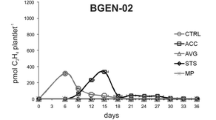Abstract
Vicia faba L. ‘Herz Freya’ (fababean) cotyledons andMycobacterium paraffinicum Bardane strain (MPB) cells were studied to describe and compare physiological and biochemical factors regulating ethylene oxidation. Both organisms demonstrated a linear rate of ethylene uptake as a function of concentration from 1 ppm to 1,000 ppm. CO2 did not influence ethylene oxidation by either organism. Zero degree temperatures and CO inhibited ethylene oxidation by fababeans but not by MPB.
An N2 gas phase blocked ethylene consumption by fababeans. In contrast, MPB continued to consume ethylene at a reduced rate under anaerobic conditions. Hydrocarbon oxidation was limited to alkenes. Alkanes were not oxidized by either organism. Both organisms were sensitive to diethyldithiocarbamic acid, o-phenanthroline, carbonyl cyanidem-chlorophenyl hydrazone, and CS2. The possibility that CS2 acted as a suicide substrate is discussed. Evidence is presented that hydrocarbon gas oxidation by fababeans is not a part of, or reflection of, the way ethylene acts as a hormone.
Similar content being viewed by others
Abbreviations
- CCCP:
-
carbonyl cyanidem-chlorophenyl hydrazone
- MPB:
-
Mycobacterium paraffinicum Bardane strain
- SKF-525A:
-
(2-diethylamino ethyl-2, 2-diphenyl valerate hydrochloride)
- DIECA:
-
diethyldithiocarbamic acid
References
Abeles FB (1973) Ethylene in plant biology. Academic Press, New York
Abeles FB (1982) Ethylene as an air pollutant. Agr and For Bull Univ Alberta 5:4–12
Beyer E (1975)14C-ethylene incorporation and metabolism in pea seedlings. Nature 5505:144–147
Beyer EM (1976) A potent inhibitor of ethylene action in plants. Plant Physiol 58:268–271
Beyer EM (1977)14C2H4: Its incorporation and oxidation to14CO2 by cut carnations. Plant Physiol 60:203–206
Beyer EM (1979a) Effect of silver ion, carbon dioxide, and oxygen on ethylene action and metabolism. Plant Physiol 63:169–173
Beyer EM (1979b) [14C] Ethylene metabolism during leaf abscission in cotton. Plant Physiol 64:971–974
Beyer EM (1980) Recent advances in ethylene metabolism. In: Jeffcoat B (ed) Aspects and prospects of plant growth regulators. Monograph 6, Brit Plant Growth Reg Groups, pp 27–38
Beyer EM, Blomstrom DC (1979) Ethylene metabolism and its possible physiological role in plants. In: Skoog F (ed) Plant growth substances 1979. Springer-Verlag Berlin Heidelberg New York pp 208–218
Beyer EM, Sundin O (1978)14C2H4 metabolism in morning glory flowers. Plant Physiol 61:896–899
Brieger H (1967) Carbon disulfide in the living organism. In: Brieger H, Teisinger J (eds) Toxicology of carbon disulfide. Excerpta Medica Foundation, pp 27–31
Cooper DY, Levin S, Narasimhulu S, Rosenthal O, Estabrook RW (1965) Photochemical action spectrum of the terminal oxidase of mixed function oxidase systems. Science 147:400–403
Croteau R, Kolattukudy PE (1974) Direct evidence for the involvement of epoxide intermediates in the biosynthesis of the C18 family of cutin acids. Arch Biochem Biophys 162:471–480
Davis JB, Chase HH, Raymond RL (1956)Mycobacterium paraffinicum n. sp. a bacterium isolated from soil. Appl Microbiol 4:310–315
De Bont JAM (1975) Oxidation of ethylene by bacteria. Ann Appl Biol 81:119–121
De Bont JAM (1976) Oxidation of ethylene by soil bacteria. Antonie Van Leeuwenhoek 72:59–71
De Bont JAM, Albers RAJM (1976) Microbial metabolism of ethylene. Antonie Van Leeuwenhoek 42:73–80
De Bont JAM, Attwood MM, Primrose SB, Harder W (1979) Epoxidation of short chain alkenes inMycobacterium E20: The involvement of a specific monooxygenase. FEMS Microbiol Letts 6:183–188
De Bont JAM, Harder W (1978) Metabolism of ethylene byMycobacterium E 20. FEMS Microbiol Letts 3:89–93
Dodds JH, Musa SK, Jerie PH, Hall MA (1979) Metabolism of ethylene to ethylene oxide by cell-free preparations fromVicia faba L. Plant Sci Letts 17:109–114
Ehrenberg L, Osterman-Golkar S, Segeräck D, Svensson K, Calleman CJ (1977) Evaluation of genetic risks of alkylating agents. III. Alkylation of hemoglobin after metabolic conversion of ethene to ethene oxide in vivo. Mutation Res 45:175–184
Jerie PH, Hall MA (1978) The identification of ethylene oxide as a major metabolite of ethylene inVicia faba L. Proc R Soc Lond B 200:87–94
Kudeyarov VN, Jenkinson DS (1976) The effects of biocidal treatments on metabolism in soil. VI. Fumigation with carbon disulfide. Soil Biol Biochem 8:375–378
Moore L (1982) Carbon disulfide hepatoxicity and inhibition of liver microsome calcium pumps. Biochem Pharmacol 31:1465–1467
Obrebska MJ, Kentish R, Parke DV (1980) The effects of carbon disulfide on rat liver microsomal mixed-function oxidases,in vivo andin vitro. Biochem J 188:107–112
Oritz De Montellano PR, Beilan HS, Kunze KL, Mico BA (1981) Destruction of cytochrome P-450 by ethylene. J Biol Chem 256:4395–4399
Powlson DS, Jenkinson DS (1971) Inhibition of nitrification in soil by carbon disulfide from rubber bungs. Soil Biol Biochem 3:267–269
Testa B, Jenner P (1976) Drug metabolism. Marcel Dekker Inc, New York, p 350
Yu Y-B, Yang SF (1979) Auxin-induced ethylene production and its inhibition by aminoethoxy-vinylglycine and cobalt ion. Plant Physiol 64:1074–1077
Wiegant WM, De Bont JAM (1980) A new route for ethylene glycol metabolism inMycobacterium E 44. J Gen Microbiol 120:325–331
Author information
Authors and Affiliations
Rights and permissions
About this article
Cite this article
Abeles, F.B. A comparative study of ethylene oxidation inVicia faba andMycobacterium paraffinicum . J Plant Growth Regul 3, 85–95 (1984). https://doi.org/10.1007/BF02041994
Received:
Accepted:
Issue Date:
DOI: https://doi.org/10.1007/BF02041994




